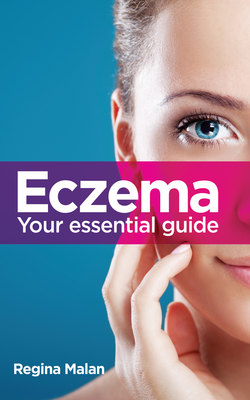Читать книгу Eczema: Your essential guide - Regina Malan - Страница 8
На сайте Литреса книга снята с продажи.
GENERAL SYMPTOMS
Оглавление•Moderate to very dry skin. Not all people with dry skin will develop eczema, but eczema is always accompanied by dry skin. Eczema skin is more porous than healthy skin and is less effective in preventing moisture loss.1 As a result of excessive moisture loss, the skin feels taut and non-elastic. White flakes of dead skin cells and scales may be present. The intense itching associated with eczema is caused by the typical dryness of the skin.
•Itching. The most distinctive symptom of eczema is the unbearable itching. Not all types of skin rash itch, but eczema always itches, regardless of the body area on which it appears. Your brain may even interpret the intense itching as painful. At night eczema becomes a demon. It keeps you awake and irregular sleeping hours lead to exhaustion and lethargy. In addition, you often scratch the skin unconsciously at night and thus worsen the problem.
•Rash. The typical itching of eczema is followed by a red, swollen, crusty rash. In people with fair skin, the rash may initially appear red, and subsequently turn brown. In dark-skinned people, skin pigmentation is affected and the afflicted area may turn lighter or even darker. Besides the itchiness, cracks or fissures may also appear behind the ears and on the palms of the hands.
•Affected areas (see Figure 2.1). In adults, eczema appears mainly in the skin folds, on the neck, hands and flexures of the arms (where the elbow bends) and legs (where the knee bends) and around the ankles. In an acute case, the whole body may be affected. In her book The Eczema Solution, Sue Armstrong-Brown relates an acute episode in which the eczema crept over her whole body, even up to the soles of her feet.
In babies, eczema generally appears on facial areas, such as the cheeks and around the mouth, and on the upper bodies. It is often the baby’s drooling that prompts the rash around the mouth. As soon as the baby starts crawling, the eczema may spread to the knees and elbows as a result of the increased friction. Eczema does not generally occur in the nappy area.
•Blisters or vesicles. During an acute phase, small fluid-filled blisters or vesicles, as well as red bumps and swelling, may appear on the skin, caused by the release of too much histamine in the tissues. For this reason, antihistamines often bring relief to eczema sufferers.
•Eczema damages the skin structure. Scratching leads to oozing of the blisters and the eczema appears wet. A thin crust and scales develop where the oozing fluid dries. This phase is generally accompanied by infection that requires antibiotic treatment.
•Painful fissures. These may gradually develop on the skin as a result of excessive dryness (see Figure 2.2).
•Thickening of the skin. Adults often display thickening of the skin caused by continuous scratching and the resultant skin damage. Lichenification, or leathery skin, as well as lesions may appear. The redness and scaliness of eczema skin are most probably the result of an overactive immune system, while the thickening and lichenification are brought about by constant rubbing and scratching.
Eczema sufferers usually scratch the itching skin with their fingernails, which damages the skin and leads to infections, but this is by no means the only way of scratching. To rub the skin, with either your hands or your clothes, also causes damage. Sufferers devise all kinds of methods to scratch the skin – with a hair brush, a towel, buttons on clothes, for example. All of these are harmful to the skin.
•An atopic fold (or Dennie Morgan fold). This is an extra line or skin fold that sometimes develops under the lower eyelids of an eczema sufferer. When the eczema flares, the eyelids also become swollen, returning to normal when the acute flare-up subsides. This results in loose, sagging skin and hence the extra wrinkle beneath the eye. The Dennie Morgan fold may occur in people of all ages, even babies, who acquire an old, wise appearance as a result of it.
•Acute flare-ups. Eczema is a chronic condition with occasional acute flare-ups. An eczema sufferer will always have a tendency towards this skin condition, even though some children ‘outgrow’ it by their teen years. It is, therefore, a chronic condition. Symptoms are much more obvious during a flare-up, which may last a few hours, a few days or even longer. What remains after the acute flare-up is the chronic part, which to a lesser or greater extent may still be accompanied by a rash and discomfort. The skin of some people is so badly affected that the difference between the chronic and acute phases is merely a question of intensity (see Figure 2.3).
